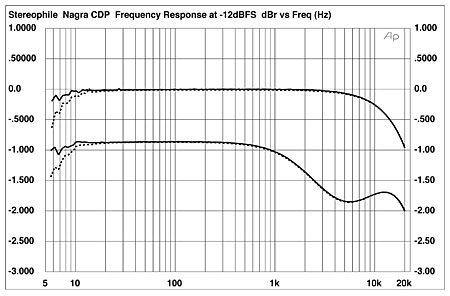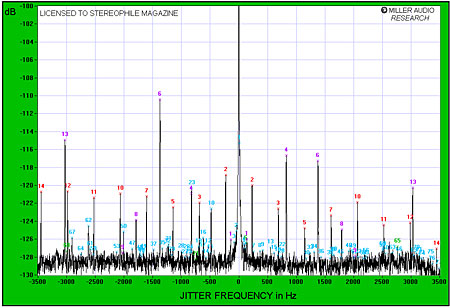| Columns Retired Columns & Blogs |
Nagra CDP CD player Measurements
Sidebar 3: Measurements
The Nagra CDP's maximum output level at 1kHz was 3.175V from its unbalanced jacks, 4dB higher than the CD standard's 2V. The balanced output was 0.67dB higher, at 3.42V. Both outputs were absolute-polarity-correct; ie, non-inverting (the XLRs are wired with pin 2 hot, the AES standard). The output impedance was a low 50 ohms from both sets of outputs at treble and midrange frequencies, but rose at 20Hz to 344 ohms (balanced) and 146 ohms (unbalanced). With preamps having an input impedance of 10k ohms or higher, this increase will not have any audible consequences.
The CDP's error correction was the best I have encountered. Monitoring the player's digital output with the RME DigiCheck program running on a PC, there were no audible glitches or flagged errors in the output datastream until track 34 of the Pierre Verany Test CD, which has laser-cut gaps in its bit spiral exactly 2mm in length. Even then, this was only at the start of the track, the rest of which played without errors. It took the 4mm data gaps in track 38 for the Nagra to mute its output, which is extraordinary. Unusually, the flag in the player's output datastream was not set when a data error occurred; instead, bit 17 became active when an error occurred. Even more unusual, bit 18 in the output word was permanently set to "1." This is irrelevant to the listening experience, but nonetheless...unusual.
The CDP's frequency response dropped almost to –1dB at 20kHz (fig.1, top pair of traces) but was otherwise flat. However, with pre-emphasized data (fig.1, bottom traces), a negative 2dB error appeared in the mid-treble. With those rare pre-emphasized CDs, the CDP will sound slightly distant or polite. Channel separation (fig.2) was superb from both sets of outputs, at better than 110dB below 500Hz. It did decrease to a still very good 80dB at 20kHz, due to the usual capacitive coupling.

Fig.1 Nagra CDP, frequency response at –12dBFS into 100k ohms without (top) and with (bottom) de-emphasis (right channel dashed, 0.5dB/vertical div.).

Fig.2 Nagra CDP, channel separation (10dB/vertical div.).
Playing back dithered data representing a 1kHz tone at –90dBFS, the Nagra's unbalanced output was free from either harmonic or power-supply–related spuriae. In fact, the 1/3-octave–wide traces in fig.3 show just the spectral content of the recorded dither noise, the player's own noise being lower than what the CD medium is capable of achieving. Extending the analysis to 200kHz with the CDP playing back a "digital black" track (not shown) indicated that the player has very little ultrasonic noise present in its output. Though a slight rise in the noise floor was visible above the audioband, it still lay at only –96dBFS at 200kHz.

Fig.3 Nagra CDP, 1/3-octave spectrum with noise and spuriae of dithered 1kHz tone at –90dBFS (right channel dashed).
Linearity error was less than ±2dB down to –110dBFS (fig.4). In fact, this graph really shows only the contribution of the recorded dither noise. The Nagra's very low level of self-noise meant that, with undithered data, its reproduction of a 1kHz tone at exactly –90.31dBFS was essentially perfect (fig.5), the three DC voltage levels being very clearly delineated. Though a very slight DC offset can be seen in this graph, it is less than 30µV, which is negligible.

Fig.4 Nagra CDP, left-channel departure from linearity, 16-bit data (2dB/vertical div.).

Fig.5 Nagra CDP, waveform of undithered 1kHz sinewave at –90.31dBFS, 16-bit data.
When it came to harmonic distortion, the Nagra CDP did well, although it was not quite as linear as the best I have measured. Fig.6, for example, is an FFT-derived spectral analysis of the unbalanced outputs while the CDP played back a 1kHz tone at 0dBFS. The THD was a low 0.003%, with the highest-level harmonic the third, at –91.5dB (0.004%). Note, however, that the fifth and seventh harmonics make appearances (circled in blue). Though both lie at –100dB (0.001%) or below, I would rather they weren't there at all. At –90dBFS (not shown), all the distortion harmonics were buried in the player's noise floor, as suggested by fig.3.

Fig.6 Nagra CDP, spectrum of 1kHz sinewave at 0dBFS into 8k ohms, unbalanced (linear frequency scale).
Distortion was as good at low frequencies into high impedances (not shown), but when I drove a full-scale 50Hz tone at 0dBFS from the CDP's unbalanced output into the punishing 600 ohm load (fig.7), the third harmonic rose to –70dB (0.03%), with now the second harmonic predominant, at –60dB (0.1%). As expected, the balanced output into the same low load had very much lower even-order harmonics, but the third was a little higher than the unbalanced output, at –63.5dB (0.07%, fig.8). Tested for intermodulation distortion, the Nagra produced a very low level of second-order difference product from an equal mix of 19kHz and 20kHz tones peaking at 0dBFS, but some higher-order components were apparent (fig.9).

Fig.7 Nagra CDP, spectrum of 50Hz sinewave at 0dBFS into 600 ohms, unbalanced (linear frequency scale).

Fig.8 Nagra CDP, spectrum of 50Hz sinewave at 0dBFS into 600 ohms, balanced (linear frequency scale).

Fig.9 Nagra CDP, HF intermodulation spectrum, 19+20kHz at 0dBFS peak into 8k ohms, unbalanced (linear frequency scale).
Finally, when tested with the Miller Audio Research Jitter Analyzer for its rejection of word-clock jitter, the Nagra CDP was superb, its output suffering from just 215 picoseconds peak–peak of jitter-related sidebands (fig.10). Other than a pair of sidebands at ±230Hz (red "2" markers), all the data-related components were close to the residual level in the test signal. The main sidebands present lay at ±1375Hz (purple "6") and ±3030Hz (purple "13"), but these are of unknown origin. They weren't present when I tested the Nagra with a different measurement system I am evaluating, which indicated just 151ps p–p of jitter. However, both systems indicated some slight spectral spreading of the central peak in the graph, due to the presence of some random low-frequency jitter. Paul Miller has conjectured that this produces a somewhat larger depiction of objects within the soundstage than is strictly accurate, coupled with a rather laid-back presentation.

Fig.10 Nagra CDP, high-resolution jitter spectrum of analog output signal (11.025kHz at –6dBFS, sampled at 44.1kHz with LSB toggled at 229Hz), 16-bit CD data. Center frequency of trace, 11.025kHz; frequency range, ±3.5kHz.
The Nagra CDP's digital-domain measurements, especially regarding its ability to cope with data errors and its rejection of jitter, are among the best I have encountered. Considered purely as a CD transport, it doesn't get any better than this. In the analog domain, the CDP works best with higher impedances, when it is almost beyond reproach, though the de-emphasis did raise my eyebrows a tad. I do wonder, however, if its signatures of harmonic and intermodulation distortion correlate with the somewhat forward soundstage presentation WP noted in his auditioning.—John Atkinson
- Log in or register to post comments



































